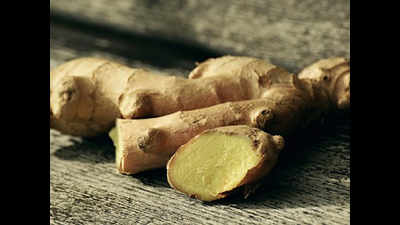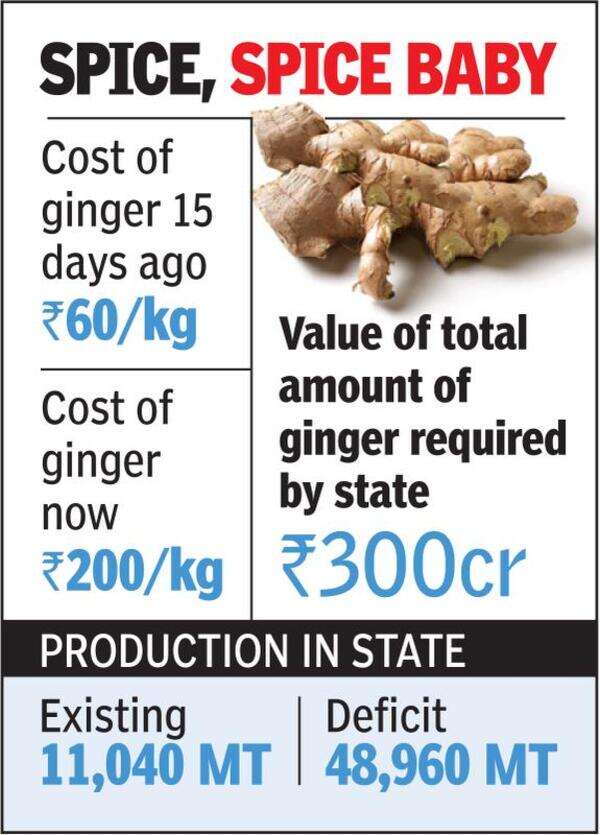- News
- City News
- Hyderabad News
- Fiery pocket pinch: Fields dry, ginger price shoots up in Hyderabad
Trending
This story is from July 17, 2019
Fiery pocket pinch: Fields dry, ginger price shoots up in Hyderabad

Image used for representational purpose only
HYDERABAD: The cost of ginger has shot up in the past 15 days in the city open market, going from just Rs 60 per kg to Rs 200 a kg. This is the highest the rate has been since 2012. Traders say the the reason for this is the crop supply from Kerala being hit due to heavy rainfall last year as well as deficit rainfall and lack of groundwater in Zaheerabad in Sangareddy district, where the crop is grown.
“The prices have gone up from about Rs 5000-6000 a quintal 15 days ago, to Rs 10,000 per quintal, at the market yards.In 2012, the price had hit Rs 16,000 per quintal. In the open market, the rate is hovering between Rs 150-Rs 200 per kg for regular consumers,” D Ananthram, a ginger trader told TOI.

Traders say the situation is likely to continue for another two or three months till markets get more supplies.
According to farmers, the increased costs and limited availability of water is forcing them to reduce cultivation. “The cost of cultivation is now around Rs 3 lakh per acre. The yield has come down drastically due to non-availability of water,” D Anjaiah, a ginger farmer from Koir mandal of Sangareddy district told TOI.
Sangareddy District Horticulture and Sericulture officer (DHSO) P Sunita said that deficit rainfall past three years has led to the cost of ginger shooting up. “Farmers can usually store their crop in the field itself depending on the availability of water. In the past three years, the monsoon hasn’t been good, and the district didn’t get enough rainfall, which may have led some farmers to release their crop in May during pickles season. Now, those who have limited stock are getting good rates, leading to high prices for consumers.”
“The prices have gone up from about Rs 5000-6000 a quintal 15 days ago, to Rs 10,000 per quintal, at the market yards.In 2012, the price had hit Rs 16,000 per quintal. In the open market, the rate is hovering between Rs 150-Rs 200 per kg for regular consumers,” D Ananthram, a ginger trader told TOI.

Traders say the situation is likely to continue for another two or three months till markets get more supplies.
Ginger is procured in bulk by the city’s vegetable vendors from Malakpet market yard which gets its supply from both Kerala and Zaheerabad. “We get about 600 quintals from Sangareddy and 300 quintals from Kerala daily,” Chandrasekhar, the secretary of Malakpet Agriculture Market Committee, said.
According to farmers, the increased costs and limited availability of water is forcing them to reduce cultivation. “The cost of cultivation is now around Rs 3 lakh per acre. The yield has come down drastically due to non-availability of water,” D Anjaiah, a ginger farmer from Koir mandal of Sangareddy district told TOI.
Sangareddy District Horticulture and Sericulture officer (DHSO) P Sunita said that deficit rainfall past three years has led to the cost of ginger shooting up. “Farmers can usually store their crop in the field itself depending on the availability of water. In the past three years, the monsoon hasn’t been good, and the district didn’t get enough rainfall, which may have led some farmers to release their crop in May during pickles season. Now, those who have limited stock are getting good rates, leading to high prices for consumers.”
End of Article
FOLLOW US ON SOCIAL MEDIA










